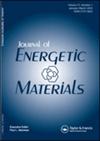描述复杂应力状态下PBX裂纹的鲁棒拉压不对称相场断裂模型
IF 1.9
3区 材料科学
Q3 CHEMISTRY, APPLIED
引用次数: 0
摘要
摘要复杂应力状态下的裂纹行为对聚合物粘结炸药在意外刺激下的安全性至关重要,但其准确描述是一个挑战。由于跟踪不连续面和多场耦合的发展,复杂断裂现象的相场模型近年来引起了人们的广泛关注。传统的相场裂缝模型是拉压对称的,或者基于体积-偏差应变能分裂,这些传统的相场模型可能导致不切实际的裂缝模式,阻碍了其在PBX裂缝模拟中的进一步应用。在这项工作中,我们提出了一个扩展的,拉伸-压缩不对称相场断裂模型,该模型区分了拉伸和压缩应力对损伤驱动能量的贡献,并耦合了机械退化和能量驱动裂纹扩散的机制。将改进的相场断裂模型应用到有限元计算中,并通过对PBX试件进行静态加载模拟,将模拟结果与传统的拉压对称相场断裂模型和体积-偏差应变能分裂相场断裂模型进行对比。结果表明,该模型不仅可以准确地描述拉伸和压缩裂纹,而且可以描述压缩辅助裂纹,同时抑制局部压应力小幅值引起的不切实际的损伤成核,是描述复杂应力状态下PBX裂纹的一种非常有效的方法。该模型在数学上和物理上都很简洁,便于数值实现。此外,由于该模型具有动态扩展和多场耦合的可行性,因此可以自然地扩展到模拟pbx的冲击诱发动态和/或耦合破裂。关键词:有限元法相场断裂聚合物粘结炸药应变能分解拉压不对称致谢本文作者感谢国家自然科学基金项目(批准号12202415)的资助。披露声明作者未报告潜在的利益冲突。补充资料本文补充资料可通过https://doi.org/10.1080/07370652.2023.2275199Additional info在线获取。基金资助:国家自然科学基金项目[12202415]。本文章由计算机程序翻译,如有差异,请以英文原文为准。
A robust tension-compression asymmetric phase-field fracture model for describing PBX cracking under complex stress states
ABSTRACTThe crack behaviors under complex stress states are very important for the safety of polymer-bonded explosives (PBXs) under accidental stimulations, but their accurate description is a challenge. Due to the advances of tracking discontinuities and multi-fields coupling, the phase-field model for complex fracture phenomena is attracting significant interest recently. Conventional phase-field fracture models are tension-compression symmetric or based on volumetric-deviatoric strain energy split, and these conventional phase-field models may lead to unrealistic fracture patterns, which hinders its further application in PBX fracture simulations. In this work, we present an extended, tension-compression asymmetric phase-field fracture model for PBXs, which distinguishes the contributions of tensile and compressive stresses to damage driving energy, and couples the mechanism of mechanical degradation and energy-driving cracking diffusion. We implemented our improved phase-field fracture model into finite element calculations and compared the simulation results with the conventional tension-compression symmetric phase-field fracture model and volumetric-deviatoric strain energy split phase-field fracture model by simulating PBX specimens under static loadings. The results show that our model not only accurately depicts the tensile and compressive cracks, but also describes compression-assisted cracking while suppressing unrealistic damage nucleation caused by small amplitudes of local compressive stresses, making it a very efficient way of describing PBX cracking under complex stress states. This new model is both mathematically and physically concise, and convenient for numerical implementation. Moreover, the novel model can be naturally extended to simulate shock-induced dynamic and/or coupled fracture of PBXs because of its feasibilities for dynamic extension and multi-field coupling.KEYWORDS: Finite element methodphase-field fracturepolymer-bonded explosivesstrain energy decompositiontension-compression asymmetry AcknowledgmentsThe corresponding author acknowledges the financial support from National Natural Science Foundation of China (Grant No. 12202415).Disclosure statementNo potential conflict of interest was reported by the author(s).Supplementary materialSupplemental data for this article can be accessed online at https://doi.org/10.1080/07370652.2023.2275199Additional informationFundingThis work was supported by the National Natural Science Foundation of China [12202415].
求助全文
通过发布文献求助,成功后即可免费获取论文全文。
去求助
来源期刊

Journal of Energetic Materials
工程技术-材料科学:综合
CiteScore
5.70
自引率
4.80%
发文量
34
审稿时长
1.8 months
期刊介绍:
The Journal of Energetic Materials fills the need for an international forum of scientific and technical interchange in the disciplines of explosives, propellants, and pyrotechnics. It is a refereed publication which is published quarterly. Molecular orbital calculations, synthetic and analytical chemistry, formulation, ignition and detonation properties, thermal decomposition, hazards testing, biotechnology, and toxicological and environmental aspects of energetic materials production are appropriate subjects for articles submitted to the Journal.
 求助内容:
求助内容: 应助结果提醒方式:
应助结果提醒方式:


